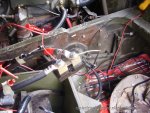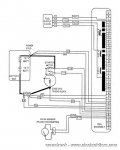- 10,350
- 74
- 48
- Location
- Meadows of Dan, Virginia
FWIW, temporarily wired in a current shunt and was able to measure the current draw during the cranking of the 8x8 engine. The big multifuel starts very easily, but I noted a reading of about 360 amps for a couple of seconds.
The newly installed Chargetek 500 had been plugged in overnight, so the batteries were fully charged.
(With a shunt in the circuit, the voltage drop is measured across it and converted to amps. This particular shunt is calibrated to read 50 mV for a current of 300 amps and my max reading was 60 mV.)
The newly installed Chargetek 500 had been plugged in overnight, so the batteries were fully charged.
(With a shunt in the circuit, the voltage drop is measured across it and converted to amps. This particular shunt is calibrated to read 50 mV for a current of 300 amps and my max reading was 60 mV.)
Attachments
-
125.7 KB Views: 281





